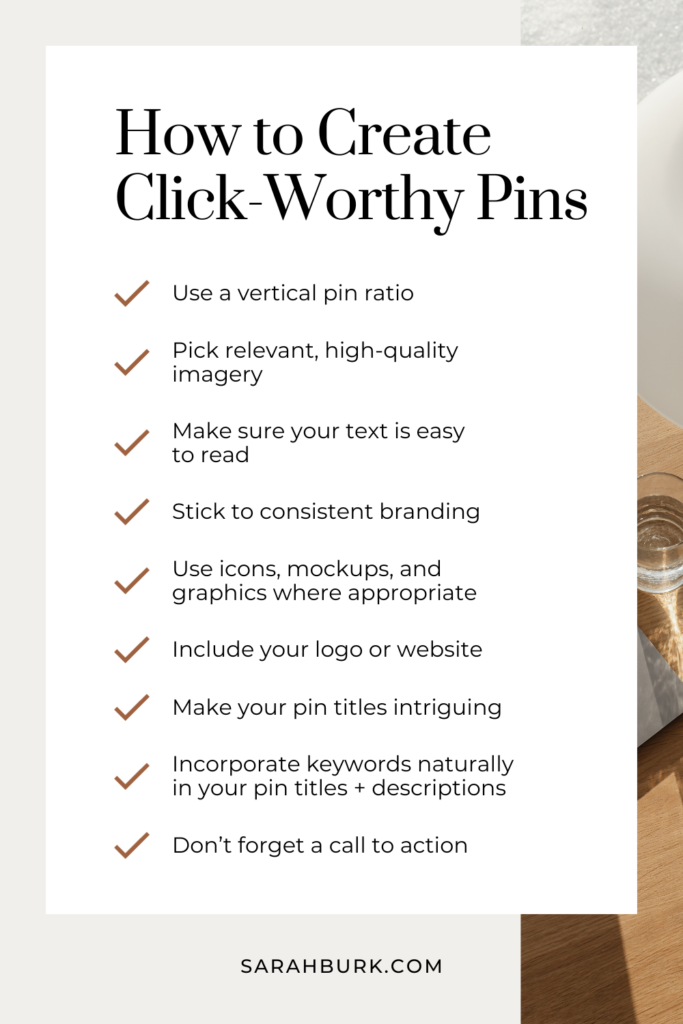With over 240 billion Pinterest pins saved and counting, there’s a lot of content on the platform. So how can businesses marketing on Pinterest cut through the noise?
Short answer: by creating SEO-optimized, visually-appealing pins that encourage users to click and convert.
Long answer: keep reading 😉
How to Create Click-Worthy Pinterest Pins
Every great pin has two things in common:
- Scroll-stopping pin design
- Keyword-rich pin copy
In this post, I’ll be sharing the ins and outs of both of these components so you can learn how to create better pins that get seen, saved, and clicked.
Before you go any further, I want to point out an important distinction.
I’m not promising any kind of formula to create “viral” pins, because going viral isn’t your ultimate goal when it comes to Pinterest marketing.
Especially as a service-based business on Pinterest, the metrics you care about are in the form of traffic, sales, and clients. Sure, having a viral pin can help those metrics, but it’s not a prerequisite to success.
Now that we’re on the same page, let’s continue.
Best Practices for Designing Pinterest Pins that Stop the Scroll
Pinterest is an incredibly visual platform. When users are scrolling through their home feed or search results, they often won’t see any of the pin copy until they actually click on the pin.
That means your Pinterest pin graphics are of utmost importance! The look of your pin designs should catch your target audience’s attention enough that they stop the scroll and want to know more about what’s behind the image.
In order to do that, here are some best practices I recommend following…
Use a vertical pin ratio
The standard recommended size for a Pinterest pin is a 2:3 vertical ratio, or 1000×1500 px.
You can absolutely create pins with different sizes, but stick to a vertical shape instead of square or horizontal. Vertical Pinterest pins take up more space in the feed and are more likely to stand out to a user’s eye.
Other acceptable pin dimensions include:
- 1080×1920 px
- 1000×1700 px
- 1000×2000 px
Pick relevant, high-quality imagery
Whether your Pinterest pin is just an image or an image with text overlay, it’s important that the images you use are relevant to the content of the pin.
Pinterest’s algorithm takes into consideration visual similarity and context when it categorizes your pin, so don’t use unrelated stock imagery “just because.”
For example: If you’re a social media manager posting about how to plan Instagram content, don’t use images of someone doing a workout in the background.
(I hope you would know this already, but I’m using an extreme example to make the point.)
A common misconception when it comes to designing Pinterest pins is that you should avoid stock images because they’re overused and won’t register as “fresh” by the algorithm.
As long as you are using the stock images as part of your overall pin design and not just posting the image itself, you’re still creating a fresh pin! In fact, using a stock image could help your pin get more visibility in the search results because Pinterest recognizes the image and the content categories it’s associated with.
Just try to stay away from anything too cheesy or outdated, k? These are some of my favorite Pinterest stock photo resources!
On that subject, whatever images or graphics you use in your Pinterest pin designs, make sure they’re high-quality. Pinterest users are incredibly discerning and no one’s going to be attracted to blurry, pixelated images.
Make sure your text is easy to read
I know script fonts are pretty. But they aren’t legible. Not to your audience and not to Pinterest, who actually scans your pin graphic to determine the content of your text.
Whatever fonts you use for your Pinterest pin text overlay, make sure they’re easy to read, especially from a mobile user experience point of view.
There are a few things to keep an eye out for:
- Don’t make your font size too small
- Make sure there’s enough contrast between the text color and the background
- Use font styles (bold, italic, underline), different colors, or other icons to place emphasis on the most important parts of your text overlay
Stick to consistent branding (for the most part)
There’s a lot of value in using consistent brand visuals across your Pinterest pins (and your online presence in general). By using the same brand colors, fonts, and styles, you’re strengthening your brand’s visual identity and building brand awareness.
But, if your branding is impeding the legibility or distribution of your pins, it’s okay to switch it up a bit.
Take a command-strip approach to your brand guidelines on Pinterest instead of super glue — sticky, but easy to change if necessary.
Use icons, mockups, and graphics where relevant
If you’ve got something to promote, promote it clearly and loudly on your pin graphics! Offering a free lead magnet? Show a mockup of the PDF to indicate users can actually get something by clicking on the pin.
In general, you can use different graphics like arrows, banners, bubbles, and more to bring attention to the important parts of your pin image.
Include your logo or website on the pin
Okay, this tip isn’t exactly necessary to make your Pinterest pins click-worthy, but it is an important tip whenever you’re designing pin graphics. I like to always include either my client’s logo, brand name, or website URL on the pin image itself for two reasons.
- It increase brand awareness and associates the content with your brand
- In the off-chance the pin gets disconnected from your account, your attribution is still on the image
How to Write SEO-Optimized Pinterest Pin Copy
Your pin copy, comprised of your pin title and pin description, is essential to making sure your Pinterest pins even show up in search results in the first place. It can also be an important deciding factor in whether a user decides to click from your pin to your website, which is where the real conversion magic takes place.
That’s why it’s essential to know how to incorporate keywords into your pin titles and descriptions! Unfortunately, it’s not as easy as just throwing a bunch of keywords and phrases into a description and calling it a day. Here’s what you should be doing instead…
Use the primary keyword in your pin title
For every pin you create, you should have at least one focus keyword that you’re targeting. I like to choose 3-5 (or sometimes more), but choose one as your primary and make sure you include that in the pin title.
Even better, try to include the board title where the pin is being saved within the pin title. Your boards should already be optimized with high-level keywords, and having the board title match the pin title is a strong SEO signal to Pinterest.
Make your Pinterest pin titles interesting or controversial
There’s lots of similar content on Pinterest, so you need to make yours stand out! When writing your pin title, try to differentiate your content from the rest by adding extra details, numbers, or asking a question. All of these will make users feel more compelled to click.
Incorporate keywords naturally throughout your pin descriptions
Do not – I repeat, do not – slam a wall of keywords into your pin descriptions. Also called keyword stuffing, this is a spammy activity and Pinterest recognizes it as such. You are much better off incorporating your Pinterest keywords throughout sentences in your description. Your descriptions don’t have to be the most perfect, engaging sentences you’ve ever written, but just avoid the rather lazy copy-paste keyword blocks.
For that matter, stay away from hashtags, too. Hashtags have always been an iffy subject on Pinterest, but they just don’t matter. Users don’t use hashtags on Pinterest the way they do on Instagram, and if you click on a hyperlinked hashtag, it simply takes you to the search results for the hashtag’s text. If that hashtag is a multi-word phrase, it searches that phrase as one word, not the phrase itself. Just stick to keywords.
Include multiple long-tail variations of your focus keyword
This is one of the biggest missed opportunities I see in most Pinterest pin descriptions. If your focus keyword is copywriting tips, I want to see multiple different iterations of that keyword in your pin description. That could include “best copywriting tips,” “copywriting tips for beginners,” and “website home page copywriting tips,” just as an example.
Don’t forget a call to action
I’ll be honest, pin descriptions aren’t the most closely read thing on the internet, but some users do pay attention to them. Don’t miss out on a chance to encourage those users to take action. Including even a simple call to action at the end of your pin description could give Pinterest users that extra push to follow through to your website (where they’ll hopefully convert to a subscriber or sale!).

Reminder: Not every pin has to be perfect
Yes, these are the best practices for creating scroll-stopping, click-worthy pins that convert your Pinterest audience. However, you don’t have to check off every single thing for every single pin.
If agonizing over your pin designs or descriptions is keeping you from publishing consistently, scale it back. There are plenty of ugly and imperfect pins that are already ranking and driving traffic to their creators’ sites.
When it comes to your pin graphics, they should be branded, easy to read, and eye-catching. Use calls-to-action, mockups, and emphasis where necessary to entice users to click.
As for your pin copy, makes sure to include descriptive keywords in the pin titles and pin descriptions, integrating them naturally throughout the sentences.
That right there sums up the basics of creating click-worthy pins, but the most important thing is that you keep creating. The more you create, the more data you’ll have to analyze and work from!
And if you really can’t fathom the idea of going it alone on Pinterest, here are a few ways I can support you…
>> Pinterest Management – Custom Pinterest strategy and content creation for the busy service-based entrepreneur ready to start driving more passive traffic, sales, and leads without ever having to log in to Pinterest themselves. Learn more here!
>> Pinterest Toolkit – Got the DIY spirit but want some tools to speed up your workflow? Grab the Pinterest Toolkit, including designed-to-convert pin templates, pre-researched keywords, and a content planning guide to keep you on track.
